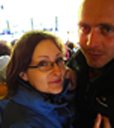




Cartagena:
Cartagena was our last stop in Colombia and in South America.
Cartagena (previously Cartagena de Indias) was founded in 1533 by De Heredia and it was named following the port of Cartagena in Spain. From its creation and during all the spanish colonial era, Cartagena was one of the most important ports in America. The city was assaulted several times by pirates and english troops (Drake, 1586) and so the king Felipe II requested the building of ramparts and forts to defend the city. The fortification is the most complete in South America. The 11 of November of 1811, Cartagena was declared independent from Spain (this day is a national feast in Colombia). Its historical centre, the "Ciudad Amurallada" or "walled city" was declared Colombian national heritage in 1959 and humanity heritage by Unesco in 1984.
From Cartagena, we were expecting to catch a boat to Panama. We arrived Friday afternoon and we found a boat for the Tuesday. We had 4 days to visit this beautiful city. Superb colonial architecture and well conserved ramparts and forts. We spent roughly 1 hour trying to find the post office as nobody knew what was the Post Office! Finally a nice and old lady helped us and I could post the presents for France. We stayed in the Hostal Casa Real which was pretty quiet except the loud TV from a room occupied by 2 guys who were drinking lots of beers!!! And that from late morning!!! We knew which program they were watching from the end of the corridor! We learnt Monday that they were from Ireland and Tuesday that they were part of our boat trip!
- The Cathedral of Cartagena,
- We went to visit the "Palacio de la Inquisicion" which displayed Inquisitor' instruments of torture and a nice architecture building. In one of the patios, a replica of the guillotine could be seen. I like this picture which shows the guillotine (in the dark, right) and the back of the cathedral. Just to remember what the "Church" has done for centuries...,
- The "Plaza de la Aduana", the oldest and largest square in the old town. Very nice but only buildings around. Missing some life here,
- The "Puerta del Reloj" or "Clock door" is the main gateway to the inner town. The clock was built at the top of the wall during the 19th century. The plaza from where I took the picture was the "Plaza de los Coches", a square used as a slave market,
- "Las Bovedas" are located between the forts of Santa Clara and Santa Catalina. It has 47 arches and 23 vaults and had a military use during the colony and during the independence it served as a jail. After its restoration, the Bovedas are now a touristic centre with lots of small shops.


No comments:
Post a Comment